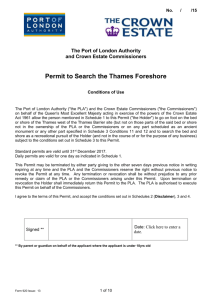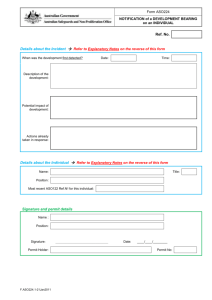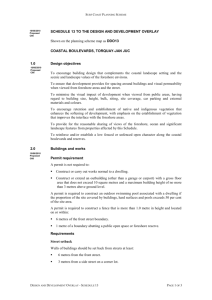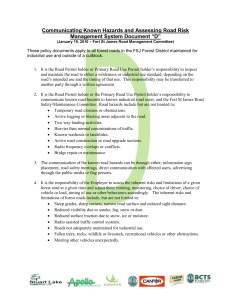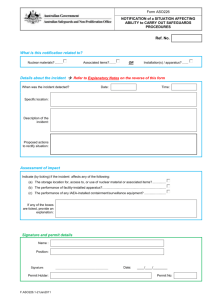Application form - complete online before printing and signing
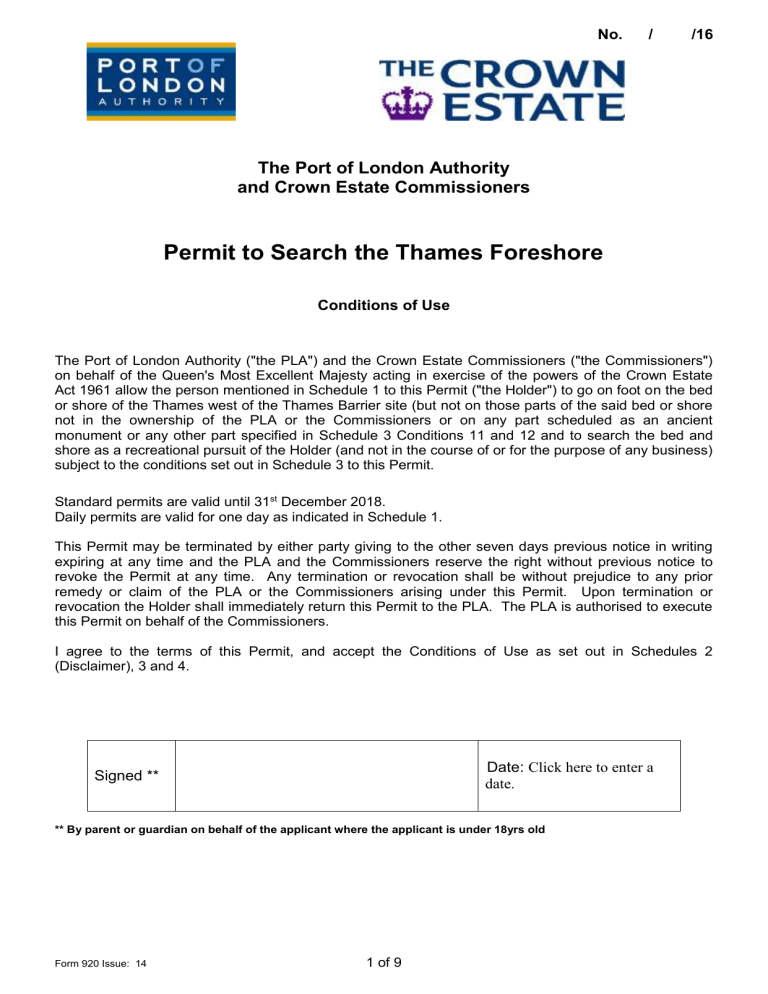
No. / /16
The Port of London Authority and Crown Estate Commissioners
Permit to Search the Thames Foreshore
Conditions of Use
The Port of London Authority ("the PLA") and the Crown Estate Commissioners ("the Commissioners") on behalf of the Queen's Most Excellent Majesty acting in exercise of the powers of the Crown Estate
Act 1961 allow the person mentioned in Schedule 1 to this Permit ("the Holder") to go on foot on the bed or shore of the Thames west of the Thames Barrier site (but not on those parts of the said bed or shore not in the ownership of the PLA or the Commissioners or on any part scheduled as an ancient monument or any other part specified in Schedule 3 Conditions 11 and 12 and to search the bed and shore as a recreational pursuit of the Holder (and not in the course of or for the purpose of any business) subject to the conditions set out in Schedule 3 to this Permit.
Standard permits are valid until 31 st December 2018.
Daily permits are valid for one day as indicated in Schedule 1.
This Permit may be terminated by either party giving to the other seven days previous notice in writing expiring at any time and the PLA and the Commissioners reserve the right without previous notice to revoke the Permit at any time. Any termination or revocation shall be without prejudice to any prior remedy or claim of the PLA or the Commissioners arising under this Permit. Upon termination or revocation the Holder shall immediately return this Permit to the PLA. The PLA is authorised to execute this Permit on behalf of the Commissioners.
I agree to the terms of this Permit, and accept the Conditions of Use as set out in Schedules 2
(Disclaimer), 3 and 4.
Signed **
Date: Click here to enter a date.
** By parent or guardian on behalf of the applicant where the applicant is under 18yrs old
Form 920 Issue: 14
1 of 9
SCHEDULE 1
The Holder
Enter details in block capitals
Applicant
Title (Mr, Mrs, Ms etc)
Surname
Choose an item.
Forename
Click here to enter text.
Click here to enter text.
Address
Post Code:
Telephone number
Mobile number
Email address
Click here to enter text.
Click here to enter text.
Click here to enter text.
Click here to enter text.
Click here to enter text.
Click here to enter text.
Click here to enter text.
Standard Permit - Indicate Permit Required
Standard Adult
Permit Type
(£72)
Standard Junior 12-17 yrs (£36)
☒
☐
☐
Applicants aged 12 – 17 years old must be accompanied by a permit holding adult
Enter D.O.B if under 18 on date of application
Name of accompanying adult
Click here to enter a date.
Click here to enter text.
Daily permit enter date required and search area
Date Search Area
Daily (£31)
Click here to enter a date.
Click here to enter text.
Please indicate if requesting payment by credit card
☐
Have you remembered to enclose a photograph?
Form 920 Issue: 14
2 of 9
SCHEDULE 2
PERMIT TO SEARCH THE RIVER THAMES FORESHORE
Disclaimer in favour of the Port of London Authority (PLA) and
The Crown Estate Commissioners
In relation to his/her application for a permit, the applicant acknowledges as follows:
1. The River Thames foreshore can be a hazardous environment. Conditions underfoot may be treacherous. In particular areas of foreshore can comprise deep mud. Surface water drainage may also have eroded the foreshore leaving holes and runnels, and there may be remnants of river works and stranded debris and rubbish, which may be a trip hazard. The
River is strongly tidal and the water level can rise very rapidly on incoming tides. Currents and the strength of the tide make it dangerous to enter the water.
2. For these reasons, care should always be taken when walking on the exposed foreshore.
In addition, sewage is still, in storm conditions, discharged into the tidal River Thames. It is not UV treated and thus contains faecal coliforms. Wading and swimming are strongly discouraged.
3. Applicants should be aware of and take precautions against health risks in using the foreshore. Hands should be washed before consuming food and drink or touching the face, eyes etc. There is always a potential danger of contracting Weils disease when digging on the foreshore and coming into contact with river water. It is recommended that tetanus and other relevant inoculations should be up to date before going on the foreshore.
4. It is strongly recommended that tide tables are consulted for the estimated time of High and Low Water on days when the applicant intends to go on the foreshore.
5. The applicant should be aware that where steps or slipways render access to the foreshore, they may become very slippery and dangerous after being covered by the tide and care must be taken when they are used.
6. Any permit issued to the applicant by the PLA is given strictly on condition that no liability attached to the PLA or to The Crown Estate Commissioners in respect of any death, injury, loss or damage sustained by the holder or to his/her property, whether arising from negligence or otherwise, while accessing or searching on the bed or foreshore.
7. The applicant understands these risks and accepts that he/she goes on the bed or shore of the Thames entirely at his/her own risk.
Form 920 Issue: 14
3 of 9
SCHEDULE 3
Permit Types and Use
1. The Holder, while on the bed or shore of the Thames shall carry the Permit ID Card issued as part of this Permit, which must, on demand, be shown by him or her to an officer of the PLA or a police officer.
2. The Holder shall pay a fee (as published by the PLA) for the issue of this Permit and the Permit ID
Card.
3. One Day or Standard Permits allow surface investigation of the foreshore only to a depth of 7.5cm (3 inches). No tools other than hand tools shall be used for such excavation.
4. A Mudlark Permit allows investigation of the foreshore only to a depth of 1.2m (3 feet 11 inches). No tools other than hand tools shall be used for such excavation. Such Permits are only available to current members of the Society of Thames Mudlarks.
5. The PLA issues a Code of Practice set out in Schedule 4 for foreshore investigation, which shall be adhered to at all times. Failure to adhere to the Code is a breach of Permit conditions and will result in revocation of the Permit.
6. Every hole (however small or shallow) must, before the Holder leaves it and before the next inundation of the tide, be refilled so that the bed or shore is reinstated as nearly as possible to its condition before the digging was started.
7. The Holder must not work on the same hole on successive low waters without refilling the hole before the tide comes in. See condition 6 above.
8. The Holder must not deposit on the bed or shore any litter nor interfere in any way with any flora, fauna, birds or fish.
9. The Holder must not interfere with any person exercising a public right to fish on the bed or shore nor with anyone mooring or boarding or landing from a vessel nor with anyone exercising any other right to be on the bed or shore nor with any river works moorings navigation aides or other similar objects on the bed or shore.
10. The Holder must comply with all legislation, rules, regulations and byelaws applicable to the bed and shore and the use he or she is making of it.
11. DIGGING IS NOT ALLOWED IN THE FOLLOWING AREAS :
11.1. The Holder must not go (and dig): a) onto private property ; or b) the foreshore in front of the Tower of London, (Tower Pier to Tower Bridge [TQ3360
8045] World Heritage Site) which are shown on the attached plan; or c) onto those parts of the bed or shore of the Thames not in the ownership of the PLA or the
Commissioners, that is: i. the former GLC foreshore at Lambeth; ii. the Bridewell Estate foreshore, Wapping; or d) in respect of a One-day or Standard Permit only , onto any part of the north foreshore between the Tower Pier and Lambeth Bridge as shown on the attached plan; or e) onto any part of the bed or shore of the Thames scheduled as an ancient monument (SAM)
There are three SAMs listed at the date of issue of this permit these are Queenhithe Dock
City of London - SAM list entry number 1001994, an area of the foreshore adjacent to the
Royal Palace at Greenwich - SAM list entry number 1410710 and the Launch Ways of the SS Great Eastern SAM list entry number 1423608.
Plans of these locations are supplied with the permit and can be viewed on the PLA’s website: http://www.pla.co.uk/Environment/Metal-Detecting-and-Digging-on-the-Thames-Foreshore
,
Form 920 Issue: 14
4 of 9
SCHEDULE 3 Contd.
f) for security reasons, as advised by the Metropolitan Police Service, on the foreshore within
10 metres of the following locations, where any parts of the locations are accessible on the foreshore at low water:
Royal Docks, Gallions Marina (Flood Barrier);
All London passenger piers;
Thames Flood Barrier in Woolwich Reach;
Gas Pipelines, Blackwall Point;
Greenwich Promenade;
HMS President (MOD);
St Katharine Dock Lock;
All London road and rail bridges;
City Hall;
Custom House;
HMS Belfast;
London Eye;
Palace of Westminster;
Thames House, Millbank;
IMO Building, Albert Embankment;
Riverwalk House, Westminster ;
No. 85 Albert Embankment; and
Barn Elms Reach - Beverly Brook (Gas pipeline)
Foreshore leased to a tenant by the PLA or the Commissioners
11.2. In addition the PLA and the Commissioners reserve the right to temporarily prohibit access to any part or parts of the bed and shore covered by this permit from time to time without incurring any liability to the Holder. This incudes locations where Licences under Section 66 of the Port of London Act 1968 have been issued and where Works are underway or being used in such a way as the PLA and/or the Commissioners consider makes it unsafe for the holder to enter onto those part or parts of the bed and shore
12. DIGGING IS RESTRICTED IN THE FOLLOWING AREAS:
12.1. All Permit Holders
Digging on the foreshore by any Permit Holder, in the following areas, is limited to a depth of 7.5cm
(3 inches): i) Putney Railway Bridge to Western Boundary of Wandsworth Park
Fish trap, remains of boats, and palaeo-ecological deposits. ii) Cheyne Walk : Opposite Munro Terrace to Battersea Bridge
Fish traps, submerged forest, Bronze Age skull. iii) Vauxhall: Upriver from Vauxhall Bridge to Riverside Court
Timber platform uprights, Bronze Age finds in association. iv) Southwark: Cannon St Railway Bridge to London Bridge
Numerous prehistoric, Roman and later finds and river structures. v) Greenwich: Greenwich Pier to Trinity Hospital
World Heritage Site.
[TQ2450 7550]
(FWW04).
[TQ2680 7740]
(FKN01).
[TQ3015 7800]
[TQ3270 8040]
(FSW12).
[TQ38607805] vi) Bermondsey: Chambers Wharf, St Saviour Dock to Fountain Stair
Flint artefacts, medieval skeleton, timber structures, nautical artefacts.
12.2. Thames Mudlark Permit Holders (in addition to areas described in 12.1)
[TQ3435 7980]
(FSW01
Digging on the foreshore by any Thames Mudlark Permit Holder, in the following area, is limited to a depth of 7.5cm (3 inches): i) North foreshore Cannon St Railway Bridge to London Bridge
Form 920 Issue: 14
5 of 9
SCHEDULE 3 Contd.
13. Reporting and Recording Regime
13.1. The Holder must contact the Museum of London within one month of finding any object of archaeological or historical interest to make an appointment to have the objects identified and recorded. The Holder must provide the Museum with full details of the location and circumstances of discovery, and leave the finds with the Museum until they have been recorded under the provisions the national Portable Antiquities Scheme (PAS). The Museum will return the objects to the finder with a copy of the identification and PAS record as appropriate.
Note: The Museum of London (PAS) will, by 1 st March each year, provide the PLA with a summary of the finds reported over the previous year, including details of the finder and where located. This information will provide the PLA with the information it requires to confirm the individual permit holders are reporting any finds they may make. The PLA may use this information when considering an application to renew a permit.
Permit holders applying to renew must indicate on their application form if any finds have been reported to the PAS during their current permit period .
13.2 Where an object found by the Holder is treasure or is believed by the Holder to be treasure, as defined by the Treasure Act 1996, then in addition to reporting the find to the Museum of
London, the Holder must notify the find to the Coroner for the district in which the object was found, within 14 days as required by the Treasure Act 1996.
13.3 The PLA and the Commissioners reserve their rights in relation to the ownership of objects found, and the granting of permission under this Permit does not operate to transfer any such rights to the Holder.
14. Miscellaneous
14.1. Metal detectors may be used on the foreshore. The PLA does not regulate the use of metal detectors. Whilst this Permit does not cover the use of metal detectors when searching the foreshore, any digging resulting from such use is always subject to the requirements of this regime.
14.2. If, while on the bed or shore of the Thames in pursuance of this Permit the Holder uses any apparatus which requires the consent or licence of any authority other than the PLA and the
Commissioners, the Holder must first have obtained such consent or licence.
14.3. Swimming is not permitted in the tidal Thames.
14.4. The Holder will indemnify the PLA and the Commissioners against all actions proceedings claims demands damages costs and losses brought against either the PLA or the
Commissioners or both of them, and relating to or arising out of the exercise of the rights granted by this Permit.
14.5. The Holder consents to his or her personal details being recorded and retained by the PLA and the Commissioners for the purpose of their estates management and the issue of relevant communications and to this information being provided to the Museum of London and the Metropolitan Police where the PLA considers it appropriate .
14.6. The parties do not intend the terms of this Permit to be enforceable by third parties under the provisions of the Contracts (Rights of Third Parties) Act 1999.
14.7. It is recommended that all persons searching and digging on the foreshore carry suitable
Civil Liability Insurance cover.
14.8. The Health & Safety Executive (HSE) publishes guidance on safety in excavations. It is recommended that Mudlark Permit Holders obtain copies of the relevant information sheet(s) and adhere to the published advice, as appropriate. (See Construction Information Sheet
No. 8).
14.9. Any notice shall be served either personally or by leaving it at the party concerned's last known address or by prepaid registered or recorded delivery post addressed to the party there.
Form 920 Issue: 14
6 of 9
SCHEDULE 4
DIGGING ON THE THAMES FORESHORE
–
A CODE OF PRACTICE
Introduction
The Port of London Authority (PLA) is the statutory harbour and navigation authority for the tidal Thames
– the outer Thames estuary to Teddington Lock. The PLA also owns much of the river bed and foreshore up to the mean high water mark. As part of this role, the PLA regulates digging and excavation of the foreshore above the Thames Barrier in conjunction with the Crown Estate
Commissioners. Annual and Daily Permits are issued by the PLA for these purposes.
Such activities have the potential to interfere with other legitimate activities and may also damage the sensitive foreshore environment. This Code of Practice has been developed to provide guidance to those involved in digging on the Thames foreshore on the requirements that are necessary to ensure the activity is carried out in a safe and sustainable manner.
Digging on the Foreshore
1. The Foreshore environment
The foreshore is a sensitive environment.
It provides shelter and feeding grounds for fish
(particularly juveniles) and also for birds. The foreshore is also important for the seasonal migrations of fish from spawning to nursery grounds. Some areas may be very sensitive at certain times of the year and digging must be avoided during these periods.
The foreshore is London's longest archaeological site and at low tides a wide range of sensitive archaeological features are exposed including prehistoric forests, quays, jetties, Anglo-Saxon fish traps and much more. Many of these sites are vulnerable to the ongoing erosive forces of the river and it is important to protect them from further erosion. It is therefore necessary to restrict or prohibit digging activities in some very archeologically sensitive areas.
2. Observe local byelaws and regulations which affect the use of the river and foreshore
Copies of PLA River Byelaws, navigational regulations and current Charges can be viewed or downloaded from the PLA website: www.portoflondon.co.uk
.
3. Restricted digging areas
There are a number of areas of foreshore where digging is not allowed or where digging is restricted to a maximum depth.
4. Back-fill all holes for safety, and to maintain the inter-tidal habitat
The foreshore will recover much more quickly, and you’ll save other animals from suffocating under spoil mounds.
Anoxic lower sediment (‘black mud’) smothers less mobile invertebrates when placed permanently on top of undisturbed, aerated mud. Mounds of black mud left alongside holes containing water deprive birds of food as the area of available mud for feeding is reduced.
The foreshore will be safer for others.
Back-filing helps to reduce pollution from heavy metals that may be trapped in the sediment.
You’ll help protect worms, shellfish and crabs from being eaten by birds.
The foreshore will look better.
Form 920 Issue: 14
7 of 9
SCHEDULE 4 Contd.
5. Replace all rocks and stones
Boulders should not be overturned, but picked up and moved to one side away for the spoil mound. This will prevent the animals and plants living on the surface of the boulder from being destroyed. Once the hole is backfilled, the boulder can be replaced in its original position.
Animals and plants are specifically adapted to where they live so it is important to replace all rocks and stones as you find them so that the animals and plants can survive.
6. Do not dig around moorings, slipways, river walls or any other structures
The combined effect of tides, waves and digging may undermine walls, piles and other structures and allow moorings to shift.
Digging around fixed structures can create conflict with other shore users and property owners.
Many of the structures on the foreshore are of considerable antiquity, and digging around these will damage them.
Anyone (under the conditions of a Mudlark Permit) wishing to dig holes deeper than 7.5cm, within 5 metres of the river wall, must seek the permission of the Environment Agency.
Excavating large holes close to the wall could undermine the tidal defences at that point.
Preparations, precautions and other advice
7. Be aware of local hazards and conditions
You may be at risk from unfamiliar tides, soft mud, quicksand, sewage and water outfalls or adverse weather.
Check the local weather forecast beforehand.
Always check the PLA tide tables and ensure you know the times of high and low water for the period you will be on the foreshore.
Sewage is still discharged, following storm events, into the tidal River Thames. It is not UV treated and thus contains faecal coliforms. Persons using the foreshore and especially those digging on the foreshore should avoid swimming in the River.
When on the foreshore or digging, always ensure that you do not consume food or touch your mouth, eyes etc without first washing your hands.
There is always a potential danger of contracting Weils disease when digging on the foreshore and coming into contact with river water.
Ensure that tetanus and other relevant inoculations are up to date before going on the foreshore.
The Institute of Field Archaeologists (IFA) publishes a Standard and Guidance for archaeological excavation. All Permit holders are advised to follow this guidance, in particular, holders of Mudlark Permits, which allow digging up to 1.2m in depth. Attention is particularly drawn to paragraph 3.3.11. A copy of this guidance is attached to this Code of
Practice.
8. Treat the foreshore with respect
Use recognisable access points with care.
Keep to the hard areas of foreshore and avoid the muddy parts.
Avoid trampling on the plants and animals, so that other people can enjoy them.
9. Tell someone where you intend to dig
Don’t forget to tell someone what time you intend to return.
Do contact them if you are delayed. It could save them calling out the emergency services.
Remember your mobile phone if you have one.
Form 920 Issue: 14
8 of 9
SCHEDULE 4 Contd.
10. Take all your litter home
Human litter causes extensive damage to the marine environment. Modern materials degrade slowly, and may threaten marine life for decades.
Litter is an eyesore that spoils the river for everyone.
Collect and remove any debris and litter you create.
11. Reporting and recording finds
Take all objects of archaeological or historical interest to the Museum or London or the Portable
Antiquities Scheme . Make sure you record the ‘find spot’ and depth. A minimum six figure grid reference is preferred.
If you need further guidance on reporting and recording finds, please contact your local Finds
Liaison Officer on 020 7814 5733.
12.
Report anything unusual or dangerous to the Harbour Master or Thames Barrier
Navigation Centre
13. Please park considerately
Complaints are sometimes received from local residents that vehicles parked by people using the foreshore block access to homes and workplaces.
14. Useful information
The PLA publishes a Riverside Code, which is available in hard copy and on its website. This
Code highlights the safety issues associated with public use of the foreshore.
In addition, the Thames Explorer Trust, on behalf of the Thames Estuary Partnership, publishes a comprehensive document – Health and Safety Guidelines for the Thames and its Foreshore, which provides useful, common sense advice for those going on the foreshore. Copies are available through the Trust on 020 8742 0057.
Useful Contact Information:
The Port of London Authority
Planning & Environment
(Foreshore Permits)
London River House
Royal Pier Road
Gravesend
Kent DA12 2BG
01474 562339
PLA Thames Barrier Navigation Centre 020 8855 0315
PLA Harbour Master
Museum of London
London Wall
London EC2Y 5HN
Portable Antiquities Scheme
Finds Liaison Officer or www.finds.org.uk/involved/regional.asp
HM Coastguard
020 7743 7900
020 7600 3699
020 7814 5733
999
Form 920 Issue: 14
9 of 9

